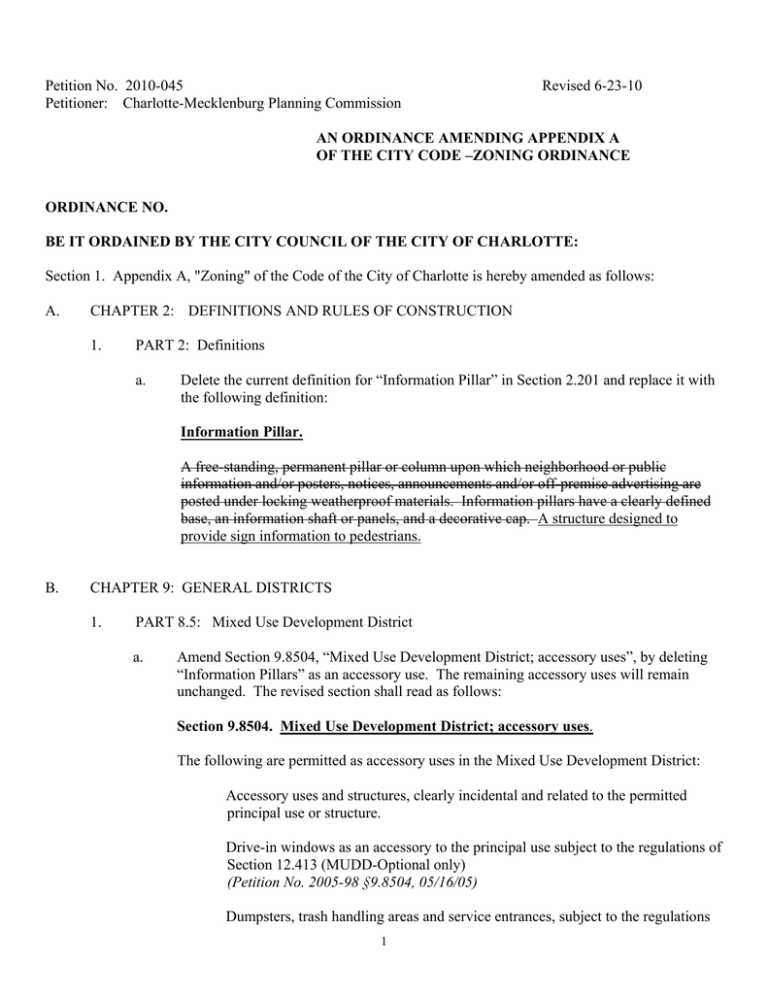Petition No. 2010-045 Revised
advertisement

Petition No. 2010-045 Petitioner: Charlotte-Mecklenburg Planning Commission Revised 6-23-10 AN ORDINANCE AMENDING APPENDIX A OF THE CITY CODE –ZONING ORDINANCE ORDINANCE NO. BE IT ORDAINED BY THE CITY COUNCIL OF THE CITY OF CHARLOTTE: Section 1. Appendix A, "Zoning" of the Code of the City of Charlotte is hereby amended as follows: A. CHAPTER 2: DEFINITIONS AND RULES OF CONSTRUCTION 1. PART 2: Definitions a. Delete the current definition for “Information Pillar” in Section 2.201 and replace it with the following definition: Information Pillar. A free-standing, permanent pillar or column upon which neighborhood or public information and/or posters, notices, announcements and/or off-premise advertising are posted under locking weatherproof materials. Information pillars have a clearly defined base, an information shaft or panels, and a decorative cap. A structure designed to provide sign information to pedestrians. B. CHAPTER 9: GENERAL DISTRICTS 1. PART 8.5: Mixed Use Development District a. Amend Section 9.8504, “Mixed Use Development District; accessory uses”, by deleting “Information Pillars” as an accessory use. The remaining accessory uses will remain unchanged. The revised section shall read as follows: Section 9.8504. Mixed Use Development District; accessory uses. The following are permitted as accessory uses in the Mixed Use Development District: Accessory uses and structures, clearly incidental and related to the permitted principal use or structure. Drive-in windows as an accessory to the principal use subject to the regulations of Section 12.413 (MUDD-Optional only) (Petition No. 2005-98 §9.8504, 05/16/05) Dumpsters, trash handling areas and service entrances, subject to the regulations 1 of 12.403. Information Pillars, subject to the regulations of Section 12.416. (Petition No. 2004-112, §9.8504,11-15-04) Outdoor lighting, subject to regulations of Section 12.402. Outdoor sales accessory, subject to the regulations of Section 12.417. (Petition No. 2006-20, § 9.8504),03/20/06) Petroleum storage, accessory to a permitted principal use or building subject to the Fire Prevention Code of the National Board of Fire Underwriters. Petroleum storage, underground, accessory to permitted automobile service stations, subject to the Fire Prevention Code of the National Board of Fire Underwriters. Signs, bulletin boards, kiosks and similar structures that provide historical information, information for noncommercial activities or space for free use by the general public. Vending machines. b. Amend Section 9.8506, “Mixed-Use Development District; urban design and development standards”, subsection (2), “Streetscape design standards”, subsection (c), “Signs, banners, flags and pennants” by adding a new subsection to reference the information pillar sign regulations. The revised language shall read as follows: (c) Signs, banners, flags and pennants. Where signs, banners, flags and pennants for identification or decoration are provided, they must conform to the requirements of Chapter 13, except for the following: 1. Specifications for permanent signs shall be according to Section 13.108a, with the following exceptions: a. Signs located on any building wall of a structure shall have a maximum sign surface of all signs on one wall not to exceed 5% of building wall area to which the sign is attached up to a maximum of 100 square feet. b. Ground mounted or monument signs shall be permitted in MUDD as follows: (1) Signs shall not exceed 5 feet in height and 20 square feet in area. A bonus of 4 square feet in size (20%) shall be permitted if the sign is lit 100% by neon light. (2) Signs shall be located a minimum of 5 feet behind the proposed right-of-way and out of any sight distance triangle prescribed by the Charlotte 2 Department of Transportation (CDOT). (3) 2. 2. Signs shall be located behind the minimum setback. Signs are permitted on an information pillar that meets all the standards and regulations in Section 13.108(b). PART 9: Uptown Mixed Use District a. Delete Section 9.904, “Uptown Mixed Use District; accessory uses”, item (2), “Information Pillars”. Renumber item (2.5), “Outdoor sales accessory”, as item (2). Other accessory uses remain unchanged. The revised text reads as follows: (2) Information Pillars, subject to the regulations of Section 12.416. (2) (2.5) Outdoor sales accessory, subject to the regulations of Section 12.417. b. Amend Section 9.906, “Uptown Mixed Use District; urban design and development standards”, subsection (2), “Streetscape design standards”, subsection (e), “Signs, banners, flags and pennants”, by modifying the language and adding a new subsection to reference the information pillar sign regulations. (e) Signs, banners, flags and pennants. Where signs, banners, flags and pennants for identification or decoration are provided, they must conform to the requirements of Chapter 13, with the following exceptions: that Off-premise Major Event Banners shall meet the following requirements: 1. Off-premise Major Event Banners The purpose this type of banner is to inform the public of major events, open to the public, with community-wide interest or regional significance. Major events may include, but are not limited to, religious, educational, charitable, civic, fraternal, sporting, or similar events including, but not limited to, golf tournaments, festivals, and major or seasonal sporting events. The banner is off-premise from the location of the major event. An off-premise major event banner differs from a “Temporary Banner” (See Section 13.106(13) in that no advertising copy is permitted on the major event banner other than that allowed in Section 9.906(e)(1)(b) below. Major event banners may be located in the UMUD zoning district provided they meet the following requirements: (a) The total area of temporary event banners combined shall not exceed 1000 square feet or 10% of the wall area, whichever is smaller, per building wall. (b) Banners shall not contain any advertising, however, up to 10% of the banner area may include the name of the major event sponsors 3 or supporters, a description of the products, services or activities provided or engaged in by the sponsors or supporters, and recognized trademarks, logotypes or symbols customarily associated with the sponsors or supporters. See Section 13.106(12) for regulations regarding on-site temporary banners that allow advertising. (c) Banners shall be erected no sooner than 7 days before the major event and removed within 2 days after the event. (d) Banners shall be attached in total to a building wall or permanent canopy extending from a building. Banners shall be adequately secured. (e) Banners shall be made of durable material. Paper banners are not permitted. (f) No inflatables, tethered balloons, streamers, pennants, flags, ribbons, spinners, or other prohibited devices shall be included or incorporated with the display of a banner under this section. (g) A written notice of the proposed banner location, number, sizes and duration shall be filed with Charlotte Center City Partners prior to issuance of a banner permit. (h) A banner permit from Neighborhood Development is required for each major event, or seasonal event. If sports related, each game or competition shall be considered a separate event. Seasonal events such as regional team sporting events (i.e. Bobcats, Panthers, Checkers, etc.) may be issued one permit for the season. (Petition No. 2005-78 §9.906(2)(e)(1)(g),06/20/05) (i) The permit number and duration shall be visible on the banner. (j) Due to the short-term nature of banners, any violation of the provisions of these regulations shall be cited by Neighborhood Development. A one-day warning notice of violation requesting immediate compliance will be issued first. Citations can then be issued for any violation that has not been corrected. (Petition No. 2005-78 §9.906(2)(e)(1)(i),06/20/05) This subsection does not preempt the regulations of Section 206 of Chapter 19, Article 7 of the City Code for decorative banners and signs. (2) 3. Signs are permitted on an information pillar that meets all the standards and regulations in Section 13.108(b). PART 12: Transit Oriented Development Districts a. Delete Section 9.1207, “Accessory Uses”, item (2), “Information pillars” in its entirety. 4 Renumber the remaining items. The new text shall read as follows: Section 9.1207. Accessory Uses. The following are permitted as accessory uses and structures in the TOD zoning districts: (1) Accessory residential uses and structures, clearly incidental and related to the permitted principal use or structure. (2) Information pillars, subject to the regulations of Section 12.416. (2) (3) Vending machines located within an enclosed building for the convenience of the occupants of the building. (3) (4) Signs, bulletin boards, kiosks and similar structures that provide historical information, information for non-commercial activities or space for free use by the general public. (4) (5) Land clearing and inert landfills (LCID): on-site, subject to the regulations of Section 12.405. (5) (6) Wireless communications facilities are only permitted atop a building or structure (other than a single family structure or other residential structure of less than two stories in height). Such facility shall not exceed 20 feet in height measured from the top of the highest point of the existing structure. Any such facility and any associated antennae located within 400 feet of a residential district shall be indiscernible from the rest of the building or structure. (6) (7) Drive-through service lanes are only permitted when associated with professional business and general offices, and only when located between ¼ to ½ mile walking distance from a transit station, as designated on the approved station area plan. Drive-through windows shall only be located on the same site as the principal use, shall be located to the rear or side of the principal use, to minimize visibility along public right-of-way. No more than four (4) drive through service lanes shall be permitted per individual use. Freestanding drive-through lanes are prohibited. b. Amend Section 9.1209, “Urban Design Standards” subsection (7), “Signs, Banners, Flags and Pennants” by adding a new subsection (g) to add that information pillar sign are permitted on information pillars. The new subsection shall read as follows: (7) Signs, Banners, Flags and Pennants. Where signs, banners, flags and pennants for identification or decoration are provided, they shall conform to the requirements of Chapter 13, except for the following: (a) Wall signs shall meet the specifications of Section 13.108a, with the exception that signs located on any building wall shall have a maximum sign surface area not to exceed 5% of building wall area 5 to which the sign(s) is attached, up to a maximum of 100 total square feet. Wall signs may be increased by 20 square feet per sign in lieu of a ground mounted or monument sign. C. (b) Signs are permitted to project up to 6’ into the minimum setback as measured from the building. Under no circumstance shall a sign project more than 4’ from the back of curb. A minimum overhead clearance of 8’ from the sidewalk shall be maintained. (c) Marquee signs are permitted. (d) Ground mounted or monument signs are allowed as follows: (1) Signs shall not exceed 5 feet in height and 20 square feet in area. (2) Signs shall be located behind the right-of-way and out of any sight distance triangle prescribed by the Charlotte Department of Transportation (CDOT). (3) Signs shall be located behind the minimum setback. (e) No freestanding pole signs shall be permitted. (f) No outdoor advertising signs shall be permitted. (g) Signs are permitted on an information pillar that meets all the standards and regulations in Section 13.108(b). CHAPTER 12: DEVELOPMENT STANDARDS OF GENERAL APPLICABILITY 1. PART 4: Accessory Uses and Structures a. Delete Section 12.416 in its entirety and re-title it as “Reserved”. The information pillar regulations are being moved into Chapter 13. The revised text shall read as follows: Section 12.416. Information Pillars Reserved Information pillars shall be permitted as an accessory uses to a rapid transit station or trolley stop, or as an accessory use to urban open space in the MUDD, UMUD, and TOD zoning district, in accordance with the following requirements: (1) Information pillars at rapid transit stations or at trolley stations shall be located on the rapid transit station site. (2) Up to two information pillars may be located in an urban open space having a minimum area of 2,000 square feet, excluding rapid transit station areas. (3) Up to three information pillars are permitted per combined rapid transit/trolley platform 6 D. (4) Up to two information pillars are permitted per rapid transit only platform. (5) One information pillar is permitted per trolley station/platform only. (6) A minimum of 1/3 of the information pillar shall be permanently available for public information, public service messages, community-wide or neighborhood events, immediate neighborhood maps, and transit information. The remaining 2/3 may be used for off-premise advertising. (7) Information pillars shall have a clearly defined base, a shaft or panels, and a decorative cap. The cap shall be compatible with the architectural style of the principal structure(s) on the property. The information shaft or panels shall be constructed of a combination of durable, weatherproof materials such as metal, glass, Plexiglas, and brick. Unacceptable materials include concrete and wood. (8) The shaft or panels shall provide a locking, transparent enclosure made of materials such as Plexiglas or glass. The enclosure will allow for the placement of interchangeable messages, information, maps, and offpremise signs. (9) The maximum height of the information pillar shall not exceed 12’. The maximum height of the information shaft shall be 10’ measured from the top of the base element to the bottom of the cap element. (10) The information shaft shall not be greater than 3.5 feet in diameter. (11) Information pillars or panels may be illuminated, but shall not cause glare. (12) Messages shall not be audible beyond 4’. (13) Video signs capable of displaying moving images similar to television images are permitted. (14) No signs shall be posted on the exterior surface of the information pillar. (15) Information pillars shall not be located in any public street right-of-way. CHAPTER 13: SIGNS 1. Modify Section 13.108(b) by moving sign and information pillar requirements into a table format, and modifying the information pillar sign regulations and the regulations for information pillars. The Charlotte Trolley will no longer operate at rail transit stations as of 7-1-10. The revised text shall read as follows: Section 13.108(b) Specifications for off-premise signs located on approved and permitted information pillars requiring a permit. The following specifications are applicable in the MUDD, UMUD, and all TOD districts. (1) Off-premise signs shall only be allowed on an approved Information Pillar. 7 (2) Up to two-thirds (2/3) of the total available area on the information pillar shaft may be used for off-premise signs. (3) If the information pillar is located less than 50’ from a public street right-of-way, a permit is required for each sign posted on the pillar. Distances shall be measured from the street right-of-way line to the nearest edge of the information pillar. (4) The procedures and application processes of Section 13.103 shall be followed for each off-premise sign within 50’ of a public street right-of-way. (5) All portions of the off-premise sign shall be placed under a locking, transparent enclosure. No signs are permitted on the exterior of the structure. Signs shall only be located on approved and permitted information pillars that meet the standards and regulations listed in Table 13.108(b), below: Table 13.108(b) Information Pillars Located at a Rapid Transit Station Information Pillars Located in a Designated Non-Residential Urban Public Open Space Area Zoning Districts Allowed MUDD, UMUD, and TOD, MUDD, UMUD, TOD, and CC Permit Required for Construction of Information Pillar Yes Yes Location of Information Pillars Information pillars shall only be located on a rapid transit platform, or within 100’ of the platform. Information pillars shall only be located in a clearly designated, non-residential, urban, public open space on an approved site plan. The designated area shall have a minimum size of 2,000 square feet. Site plans without such a designation require location approval from the Planning Director or his/her designee, prior to issuance of a permit for the information pillar. Information pillars shall be located a minimum of 50 feet from a public right-of-way, measured from the back of the existing or future curb, whichever is greater, to the nearest edge of the information pillar. Information pillars shall not be located in any sight distance triangle. Total Number of Pillars Permitted Maximum of two (2) information pillars per rapid transit platform, 8 Maximum of two (2) information pillars per nonresidential parcel that contains a pedestrian oriented mixed-use or multi-use development. Design and Materials of Information Pillar Height of Information Pillar and Shaft Information Pillars Located at a Rapid Transit Station Information Pillars Located in a Designated Non-Residential Urban Public Open Space Area Information pillars shall be a monument type structure with a vertical dimension that is greater than the horizontal dimension. The pillar shall have a shaft or panels designed for public service information and signs; a clearly defined base flush with the ground; and a decorative cap distinguishable from the shaft. The information pillar shall be constructed of durable, weatherproof materials such as metal, glass, Plexiglas, brick, or plastic, excluding concrete and wood. See Figure 13.108(b). Same Maximum height of the information pillar shall be 9 feet measured from grade to the top of the cap. The information pillar shaft shall have a maximum height of 7 feet. Same Width or Diameter of Pillar Maximum width or diameter shall be 3 ½ feet. Illumination of Information Pillars The information pillar may be illuminated, but shall not cause glare. Same Sign Permits Individual sign permits are not required if signs are located on an approved and permitted information pillar. Same Allowed Sign Types On-premise signs, off-premise signs, advertising signs, public service information signs, and video signs capable of displaying moving images similar to television images are permitted on the information pillar. Same Sign Limitations A minimum of 1/3 of the information pillar shaft or panels shall be permanently available for public service information signs. Location of Signs All portions of a sign shall be placed under a transparent enclosure and shall only be located on the information shaft or panels. Same 9 Same Same Information Pillars Located at a Rapid Transit Station Information Pillars Located in a Designated Non-Residential Urban Public Open Space Area Audio Messages shall not be audible beyond 4 feet from the pillar shaft. Same Video Signs Video signs with moving images shall be screened from view from a street. Same Figure 13.108(b) An example of an information pillar and three different shaft shapes. Section 2. That this ordinance shall become effective upon its adoption. Approved as to form: ______________________________ City Attorney I, ____________________, City Clerk of the City of Charlotte, North Carolina, DO HEREBY CERTIFY that the foregoing is a true and exact copy of an Ordinance adopted by the City Council of the City of Charlotte, North Carolina, in regular session convened on the ______day of ____, 2010, the reference having been made in Minute Book ____, and recorded in full in Ordinance Book ______, Page(s)______________. WITNESS my hand and the corporate seal of the City of Charlotte, North Carolina, this ____ day of _________________, 2010. ________________________ 10



